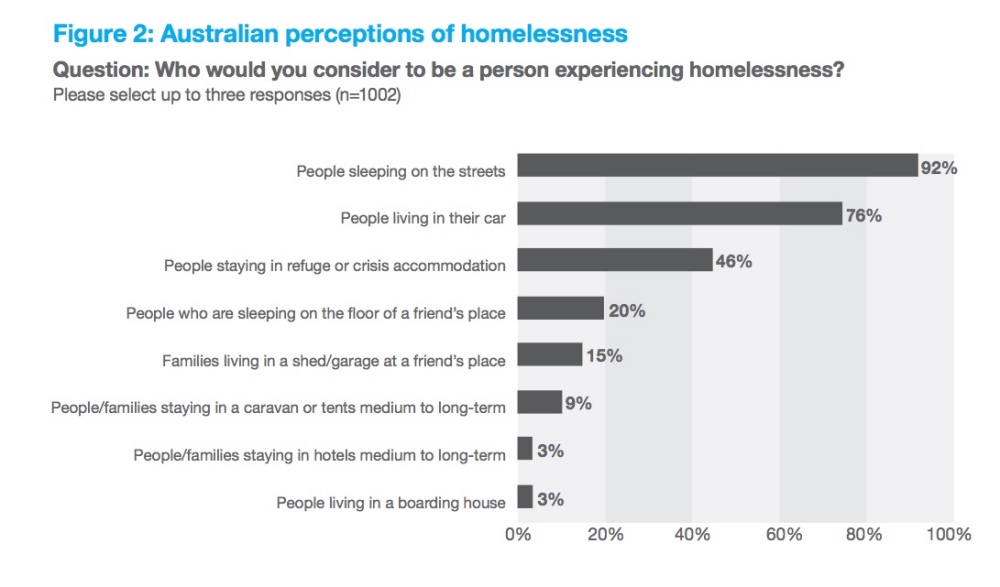Nine out of 10 Australians associate homelessness with someone sleeping on the streets and seven out of 10 with someone living in their car but just two out of 10 with people sleeping on the floor of a friend’s place and less than one out of 10 with people staying in a tent or caravan in the medium to long term, according to new research.
The findings come despite data showing that only six per cent of the country’s homeless population are rough sleepers and that the majority of them are in fact living in over-crowded dwellings, couch surfing or staying with family members or friends in a garage or caravan.

Source: Perceptions of homelessness in Australia: How to make our compassion count (Wesley Mission)
A national survey commissioned by Sydney-based Wesley Mission looking into the perceptions of homelessness in Australia, showed that while 92 per cent believe people sleeping on the streets are experiencing a form of homelessness, only 20 per cent believe that sleeping on the floor at friend’s home is a form of homelessness and only 15 per cent believe families living in a shed or garage at a friend’s place is. Just nine per cent believe staying in a shed in the medium to long term is a form of homelessness and three per cent that staying in hotels medium to long term a boarding house is.
The survey of 1002 people – including 503 people in New South Wales, was carried out by McCrindle Research in November, 2017. It reveals what researchers say are “some universal misconceptions about homelessness and that there is clearly a lack of public awareness as to what homelessness really looks like”.
Writing in the forward of the report, Rev Dr Keith Garner, CEO/superintendent of the Wesley Mission, said equating homelessness exclusively with rough sleeping “perpetuates the myth that only people living on the streets are deserving of our support, while ignoring the fact that nine out of ten people experiencing homelessness are couch surfing, living in massively overcrowded conditions or in caravan parks or residing in insecure lodgings such as boarding houses or a relative’s garage”.
“Sadly such perceptions shape public views on the causes of homelessness: the vast majority of those surveyed believing the major contributors to homelessness are drug and alcohol addiction, unemployment and mental health issues,” he wrote. “It is significant that people saw housing/rental affordability and household debt as less important factors. Such strongly held beliefs not only discriminate against people experiencing homelessness but have the potential to define and regulate community and government responses.”
The report cited ABS data showing that between the 2011 and 2016 Censuses, the number of people who experienced homelessness grew from 105,237 to 116,427 – a figure which represents 50 people for every 10,000 Australians. The biggest increase was seen in New South Wales where the number of people experiencing homelessness jumped from 28,191 in 2011 to 37,718 in 2016.
The report also showed that, when asked which of nine answers best describes why people experience homelessness (the respondants could choose up to three), 59 per cent of Australians selected drug or alcohol addiction, 44 per cent selected unemployment, 43 per cent mental health issues and 35 per cent domestic violence. Just 29 per cent believed housing/rental affordability best described why people experienced homelessness and just 16 per cent selected household debt.
Australians, meanwhile, were fairly evenly spread over what was the most effective way of helping people experiencing homelessness with 56 per cent indicating they believed providing more permanent public or social housing was an “extremely” or “very” effective way of doing so and a similar percentage indicating they believed creating safer places for people and families to live temporarily was. Some 52 per cent indicated investing in homeless shelters or refuges was “extremely” or “very” effective in addressing homelessness while 49 per cent said building more affordable, private housing was.
The report makes a number of recommendations, including that there be “increased availability of social and affordable housing which is safe, suitably located and affordable”, for flexible and sensitive housing facilities for families and individuals including those with pets, and for long-term “wrap-around” services to support people to permanently leave homelessness behind them. It also includes a number of recommendations for the media, including improved media reporting showing the “complex experiences of homelessness”.





